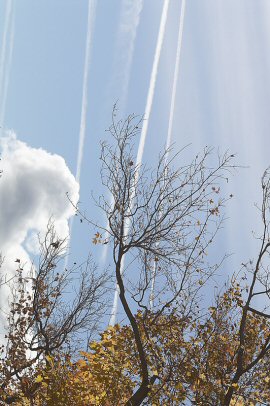6 September 2007
Ozone And Skin Oils Make For Unhealthy Airplanes
by Kate Melville
 Poor cabin air quality on airplanes could in large part be caused by skin oils interacting with ozone. A study in Environmental Science & Technology suggests that these interactions could lead to the formation of chemical byproducts that might worsen nasal irritation, headaches, dry eyes and lips, and other common air traveler complaints.
Poor cabin air quality on airplanes could in large part be caused by skin oils interacting with ozone. A study in Environmental Science & Technology suggests that these interactions could lead to the formation of chemical byproducts that might worsen nasal irritation, headaches, dry eyes and lips, and other common air traveler complaints.
In simulated flights, American and Danish researchers found that ozone in the cabin increased production of identifiable chemical byproducts including nonanal and decanal, a pair of aldehyde compounds associated with headaches, nasal irritation and with other symptoms of "sick building" syndrome.
The bulk of the byproducts were the result of reactions with skin, hair and clothing, according to study author Charles Weschler, from the University of Medicine and Dentistry, New Jersey. These oxidative byproducts are produced when ozone reacts with squalene, oleic acid and other compounds in natural skin oils, he explained.
"The role of these byproducts in the adverse health effects that have been associated with ozone is, at present, unknown," Weschler said. "If these oxidation products are demonstrated to be harmful, simple steps can be taken to reduce their production in aircraft and buildings. For instance, installing ozone-destroying catalysts in airplane ventilation systems can help remove most of the ozone from incoming air," he noted.
At cruising altitude, the atmosphere outside of aircraft contains very high ozone levels, frequently topping more than 500 parts per billion (ppb). According to FAA regulations, cabin ozone levels should not exceed 250 ppb at any time flying above 32,000 feet or average more than 100 ppb during any 4-hour flight segment that includes cruising at or above 27,000 feet.
While most wide-body planes are equipped with ozone-destroying catalysts in their ventilation systems, these catalysts are far less common on narrow-body aircraft. And as a result, ozone in the cabin air of narrow-body planes can; "exceed ozone levels in Washington, D.C., on a smoggy day," Weschler said.
Related articles:
Ozone - The Pollutant That Got Away
Sky high superhighway pollution
Smog And Women - A Bad Combination
